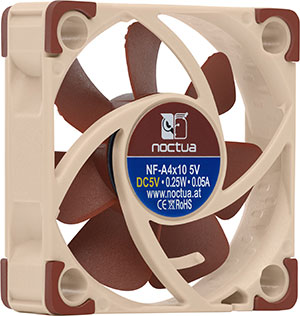Hanging out with hotspots
Revised: Oct 2023; CC BY-SA![]()
As of Jan 1, 2024, this site is no longer being updated. It will remain available for some time for legacy reference.
Most up-to-date version: amateurradionotes.com/hotspots.htm
Disclaimer: These are my personal notes and opinions based on my experience playing around with hotspots, as well as by learning from what others are sharing. I'm not affiliated with any hotspot projects, except as an ordinary user. I pay for all my equipment and do not accept freebies in exchange for reviews. If anything needs correcting, please let me know![]() .
.
1) Overview
A personal, low-power hotspot is a combination of hardware, firmware, and software that enables an amateur radio enthusiast with internet connectivity to link directly to digital voice (DV) systems around the world. Hotspots can link to DMR, P25, and NXDN talkgroups; D-STAR reflectors; YSF rooms; and so on.
Basically, hotspots are your own personal digital voice repeater and gateway, which can be really fun.
Here's a simplified diagram of what it looks like when you connect via your hotspot to a BrandMeister-hosted multiprotocol talkgroup, which enables people using different modes to talk with each other:

Notes: Some multi-mode hotspots are themselves capable of directly communicating to different modes.
HBlink![]() (Home Brew Link) = An open-source, amateur radio networking protocol
(Home Brew Link) = An open-source, amateur radio networking protocol
OpenBridge![]() = An open protocol to link DMR servers
= An open protocol to link DMR servers
NXDN and P25 work similarly to YSF.
Oct 2022 update: This diagram is now out of date, though it still gives an idea of the interconnectivity that is possible. For current info, see: XLX303 Updates![]()
For someone like me who doesn't live within range of a digital voice repeater, a hotspot goes beyond being fun to being a critical key to accessing digital voice systems, a gift that opens doors to the whole wide world.
Overall, this is an exciting area of amateur radio that is evolving and progressing rapidly with some excellent work being done by some very innovative hams (there's a shoutout to some of these folks![]() at the end of this article).
at the end of this article).
1a) Background
This is an article about personal, low-power hotspots, also known as personal access points1, not repeaters. (For info about digital repeaters, see: How to make a MMDVM Digital Repeater by N5AMD![]() and Repeater Builders
and Repeater Builders![]() .)
.)
- Many personal, low-power hotspots are boards that mount on small computers like the Raspberry Pi, a few are all-in-one boards, and some others are thumb drives that plug into computers. There's even an experimental one that's a handheld radio that plugs into a Raspberry Pi via USB.
- Some can handle many digital modes, including DMR, D-STAR, YSF, P25, NXDN, various cross modes, and POCSAG; others are limited to only one or a few modes.
- Most hotspots have stubby or onboard ceramic antennas for nearby connectivity and require a digital voice-capable radio to work with them. A core component of a digital radio is an AMBE® chip, which compresses the digitized signal and adds error correction.
- Another type of hotspot is the SharkRF openSPOT, which has its own AMBE® chip, which adds additional capability for transcoding between modes like D-STAR and DMR. When the AMBE® chip is used this way, a digital radio is still needed.
- There's another type of hotspot that has its own AMBE® chip so you can operate it without the need for a digital radio, for example, by using a headset with a microphone that is connected to the computer the hotspot is plugged into; however, this type of hotspot isn't very common.
I've been playing around with personal, low-power hotspots since 2016. During that time, I've tried a bunch of devices and apps including a whole range of MMDVM-based hotspots running an app called Pi-Star (discussed in more detail in the Playing with Pi-Star article![]() ), several generations of SharkRF openSPOTs running their own software, and several older models, most now discontinued. I discuss my experiences with my current favorite hotspots in this article.
), several generations of SharkRF openSPOTs running their own software, and several older models, most now discontinued. I discuss my experiences with my current favorite hotspots in this article.
1b) Digital ham radio nets
Nets
WØCHP's Digital Radio Lists – The data for these lists is updated hourly directly from the source APIs. The lists are can be easily searched, sorted, and downloaded, and they are mobile-friendly. https://w0chp.net/digital-radio-lists/![]()
Ham Radio DMR Nets Telegram group – A good resource for finding DMR nets. It has a quite comprehensive list of active DMR nets. Each net is displayed an hour before it goes live, making it easy to find out what's currently on the air: https://t.me/HamRadioDMRNets![]()
A good learning net – SkyHub Link System's Digital Learning Net![]() . Hosted by KE0DC and W0SUN and held on Wednesdays at 19:00 (7pm) MST, it's an hour of Q&A about everything digital radio.
. Hosted by KE0DC and W0SUN and held on Wednesdays at 19:00 (7pm) MST, it's an hour of Q&A about everything digital radio.
- BM DMR TG 310847
- WIRES-X 46361
- YSF 92722
- D-STAR XRF031 C
Related Telegram Group: Digital Learning Net![]()
Telegram groups
Amateur Radio Telegram groups – A good list of other Amateur Radio Telegram groups compiled by Tom, W2XQ. Posted on the Colorado Digital website's Resources page: Ham Radio Telegram Channels![]() .
.
1c) Hotspot best practices
The regulations and best practices that apply to amateur radio—including use of frequencies, control of our stations, and on-air courtesy—also apply to our use of personal, low-power hotspots. It's our responsibility to understand and adhere to these regulations and best practices.
My personal practice is that I power on my personal, low-power hotspots only when I'm monitoring and in control of them, adhere to my local band and frequency use plans, and leave adequate pauses between transmissions. For more about this, see Hotspot best practices![]() .
.
2) The hotspots
Disclaimer: Again, these are my personal notes and opinions based on my experience playing around with hotspots, as well as by learning from what others are sharing. I'm not affiliated with any hotspot projects, except as an ordinary user. If anything needs correcting, please let me know![]() .
.
- Since 2016, I have tested and used a bunch of different hotspots. These are my current favorites:
2a) LoneStar MMDVM devices
By David, N5BOC; firmware by Andy, CA6JAU (juribeparada / MMDVM_HS![]() )
)
These MMDVM-capable boards, designed in Texas, are well made of quality components, use good design techniques, and work with DMR, D-STAR, YSF, P25, NXDN, and POCSAG, as well as various DMR and YSF cross modes. A digital voice radio is required.
These are beautiful boards, crispy laid out, with a lustrous deep blue finish. While that isn't an essential element of a radio/modem board, it is nice, and I appreciate the craftsmanship, care, and sense of aesthetics that went into designing and making these boards.
LoneStar MMDVM Simplex
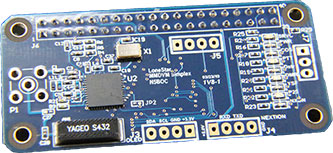 This board is the same size as and works well mounted on a Raspberry Pi Zero W/Zero 2 W. It also can be mounted on the faster RPi 3B+, 3A+, or 4B, as well as most of the older RPi boards.
This board is the same size as and works well mounted on a Raspberry Pi Zero W/Zero 2 W. It also can be mounted on the faster RPi 3B+, 3A+, or 4B, as well as most of the older RPi boards.
It's a well-designed, four-layer board with a YAGEO 432 MHz ceramic antenna (as well as SMA through-holes), and a large ground plane sandwiched in the middle, which results in well-isolated signals. Supports OLED and Nextion displays. From the website:
… this board has its own dedicated 3.3V regulator and does not pull voltage off of the noisy Raspberry Pi 3.3V line like all other simplex board do. This board is now a 4 layer board with LARGE ground planes for 3.3V and GND sandwiched in the middle. This acts as one very large decoupling cap the side of the entire board. Also this isolates signals between TOP side and BOTTOM side. Speaking of that all of the Analog RF signals are on the TOP side only and the high harmonic digital signals are all kept isolated on the BOTTOM side. Making this board much more stable.
The LoneStar MMDVM Simplex I received didn't require any RxOffset, and it stated that on the box, so it looks like he tests the individual boards before shipping them.
Setup, support, and ordering info
- Radio/Modem Type:
LoneStar - MMDVM_HS_Hat for Pi (GPIO) - Firmware upgrade script:
sudo pistar-mmdvmhshatflash hs_hat - Order directly from David via his website: N5BOC store

- Documentation: N5BOC MMDVM Documentation

- Contact: There's a contact form on the N5BOC website

LoneStar MMDVM Duplex
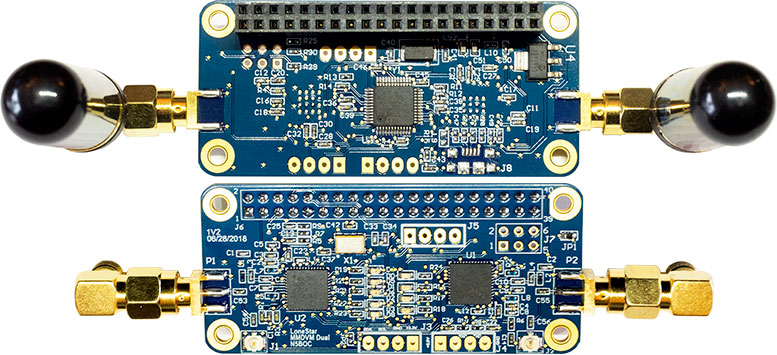
It's obvious that David has done some clever work to make a duplex board with quality components and good design practices with a Raspberry Pi Zero W form factor, the first duplex board to accomplish this. Works very well. Quite an accomplishment! It also can be mounted on the faster RPi Zero 2 W, 3B+, 3A+, or 4B, as well as most of the older RPi boards.
I like it that the SMA antennas are a bit further apart then on some of the other duplex hotspots I've used or seen. Also supports both OLED and Nextion displays.
From the website:
This board was designed by myself and all boards are fully assembled here in the great state of Texas using only the highest quality components. This can make a big difference to you. For example this board uses an ECS brand TCXO purchased from Mouser in Mansfield Texas. ECS is known for their quality of oscillators and this one is no exception. They are consistently on frequency with a very low drift over temperature.…
Much care was taken during the design and layout of this board. This board is built on a 4 layer Gold Plated PCB which is 1.6mm thick. The gold plating give the best solder adhesion (no pesky cold solder joints) and makes the board more resistant to oxidation for the absolute highest possible reliability. The inner layers are solid POWER and GROUND planes. This is important because it makes the receiver more immune to noise and therefore more sensitive. This also allows every component on the board to have a very low impedance path to either the +3.3V rail or GND which also improves the noise immunity. Lastly the plane layers being the inner layers act as one VERY LARGE decoupling capacitor which makes this board much more immune to voltage glitches on the power supply.
Setup, support, and ordering info
- Setup PDF: De N5BOC MMDVM Duplex Setup Instructions

- Radio/Modem Type:
LoneStar - MMDVM_HS_Dual_Hat for Pi (GPIO) - Radio Frequency RX and TX offset: 5 MHz
- Firmware upgrade script:
sudo pistar-mmdvmhshatflash hs_dual_hat - PDF of the LED layout on the bottom of the board: Dual board LEDs

- C4Labs case designed specifically for this board: DRZ-1S
 . The case has enough space inside for an optional OLED display.
. The case has enough space inside for an optional OLED display. - Order directly from David via his website: N5BOC store
 .
. - Documentation: N5BOC MMDVM Documentation

- Contact: There's a contact form on the N5BOC website

LoneStar-based DMRspot Premium hotspots by 27Labs
If you're looking for a preassembled MMDVM-based hotspot in a good custom case with an OLED display and a Raspberry Pi Zero W, then the DMRspot Premium Hotspots![]() are good ones to consider.
are good ones to consider.
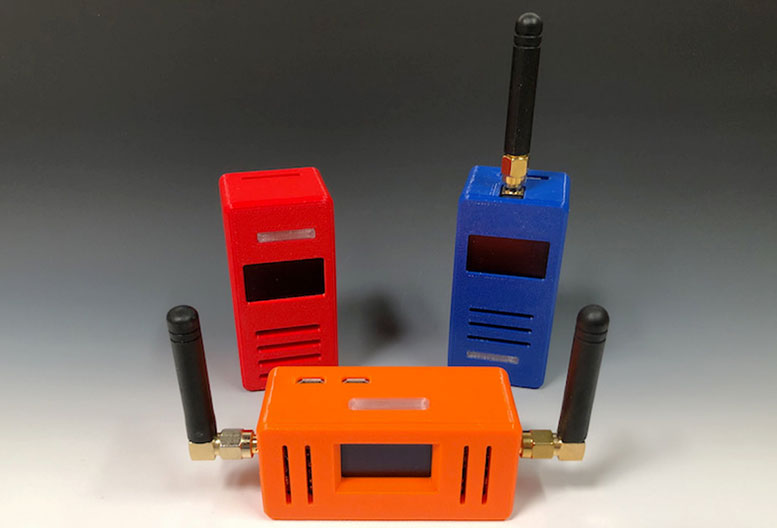
The DMRspot Premium Hotspots![]() are based on the high-quality LoneStar MMDVM devices by David, N5BOC (it's well worth a few extra bucks to get these premium boards). They can be ordered in three variations: simplex with ceramic antenna, simplex with stubby antenna, or duplex. They offer a wide variety of case colors.
are based on the high-quality LoneStar MMDVM devices by David, N5BOC (it's well worth a few extra bucks to get these premium boards). They can be ordered in three variations: simplex with ceramic antenna, simplex with stubby antenna, or duplex. They offer a wide variety of case colors.
Note: Pre-assembled MMDVM hotspots take away from the ham what is, in my opinion, a fun aspect of hotspots: the ability to learn and explore by putting them together ourselves. Still, while I don't use these myself, I can certainly understand why they are attractive to some. And at least these are good quality.
2b) SharkRF openSPOT
By Ákos Marton, HG1MA, and Norbert Varga, HA2NON.
Note: The currently available models are the openSPOT4 and 4 Pro![]() . I haven't personally tried them yet, but they look great. Here's an excellent review of the SharkRF openSPOT4 PRO by Tom, M7MCQ:
. I haven't personally tried them yet, but they look great. Here's an excellent review of the SharkRF openSPOT4 PRO by Tom, M7MCQ:
OPENSPOT4 PRO - THE BEST HOTSPOT?![]()
Here are a few observations that apply to the discontinued but still supported openSPOT3 and openSPOT2, both of which I use:
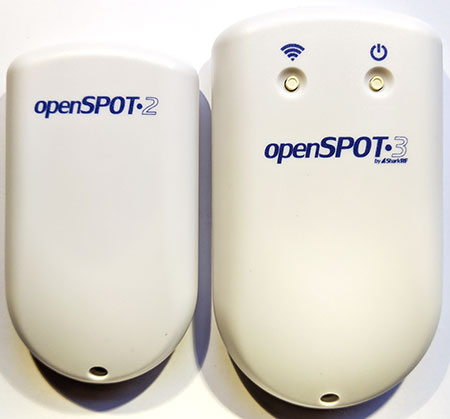
- It's quick and easy to get an openSPOT up and running initially, and they're very fast in use.
- Even though the basics are quick and easy to use, the openSPOTs are sophisticated and capable, with many advanced options and features. Check the Advanced box to access them.
- They have their own very good and easy-to-use browser-based control panel that works well when viewed on a desktop monitor, a tablet, or a cell phone. It includes a status dashboard, regular and advanced configuration options, and a Quick Setup button for easy mode changes.
- Since all the components are on a single board, they're slim and compact, smaller than any other hotspots I know about. They include both WiFi and RF antennas inside their cases.
- The openSPOT firmware and web-based control panel are being actively developed with regular releases adding new features and fixes The firmware upgrade process happens automatically in the background while the openSPOT is running. The also automatically update the callsign data.
- They work with D-STAR, DMR, YSF, P25, and NXDN radios, include cross-mode functionality, handle POCSAG, and support APRS messaging and location data forwarding. They require a digital radio.
- SharkRF
 provides a comprehensive online user manual for each model, as well as a robust community forum for support.
provides a comprehensive online user manual for each model, as well as a robust community forum for support.
SharkRF openSPOT3
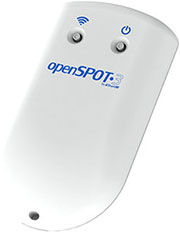 The openSPOT3 was released Jan 2020. It has been discontinued, but is still supported.
The openSPOT3 was released Jan 2020. It has been discontinued, but is still supported.
For me, the most Interesting upgrade of the Shark RF openSPOT3![]() is that it incorporates an onboard AMBE® chip for hardware transcoding so that D-STAR cross modes are now possible in a personal hotspot.
is that it incorporates an onboard AMBE® chip for hardware transcoding so that D-STAR cross modes are now possible in a personal hotspot.
Cross modes supported include D-STAR to DMR and DMR to D-STAR, as well as D-STAR to NXDNReflector, NXDN to D-STAR REF/XRF and DCS/XLX, and D-STAR gateway usage with C4FM transceivers.
The openSPOT3 also includes a built-in 3.7V 1200 mAh battery, which is replaceable. The hotspot now chirps and beeps, and the sounds have a nice character and their volume can be adjusted. For those of you who like to take a walk on the dark side, there's now a dark mode available for the control panel.
It has "range extended" antennas: a Freedom FXP72 WiFi patch antenna and a helical RF antenna, perhaps something like the Pulse Electronics CW3127![]() . So far, my subjective results with the performance of the antennas has been good.
. So far, my subjective results with the performance of the antennas has been good.
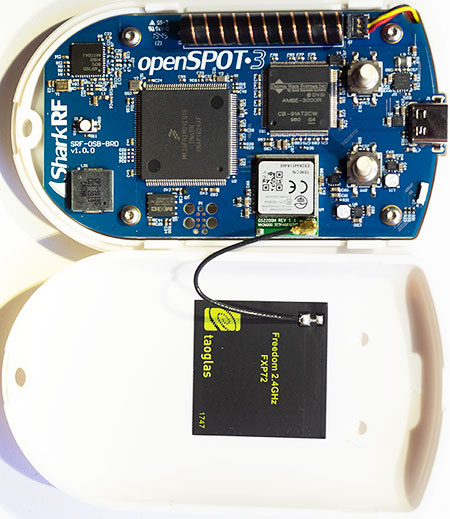
Setup and ordering info
- SharkRF openSPOT3

- SharkRF openSPOT3 online user manual

- SharkRF openSPOT3 firmware changelog

- SharkRF openSPOT3 Community Forum

SharkRF openSPOT2
 The openSPOT2 was released Oct 2018. It has been discontinued, but is still supported.
The openSPOT2 was released Oct 2018. It has been discontinued, but is still supported.
Since it combines the radio/modem and computer onto a single board (2-7/8″×1-1/2″) that is only slightly bigger than a Raspberry Pi Zero (2-9/16″×1-3/16″), it's the most compact hotspot I know of. Here it is compared to a Lonestar MMDVM Simplex with a ceramic antenna mounted on an RPi Zero W:
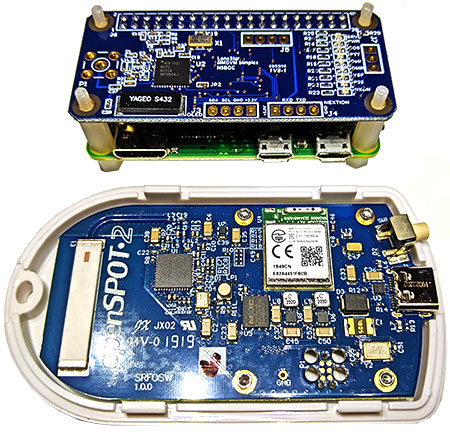
The only thing I didn't like about the openSPOT2 out of the box is the bright, multi-colored LED light. While it's helpful (the different colors and blinking patterns convey a wealth of information about the functioning of the device![]() ) I simply don't like bright, pulsing LEDs. No problem, though, you can adjust the brightness in the control panel. Nice! Sure wish my MMDVM-based hotspots had that option.
) I simply don't like bright, pulsing LEDs. No problem, though, you can adjust the brightness in the control panel. Nice! Sure wish my MMDVM-based hotspots had that option.
I don't think I can sum it up any better than David, KK4MHI, did in his comment in the SharkRF Community Forum: "It just works. Period. Bottom-line – if you [want] rock-solid reliability and don't feel like learning Linux or playing with Raspberry Pi images … go with the OpenSPOT."
Setup info
- SharkRF openSPOT2 online user manual

- SharkRF openSPOT2 firmware changelog

- SharkRF openSPOT2 Community Forum

Some final notes about the openSPOT3 & 2
The openSPOT3 is bigger than the openSPOT2, but still slim and portable. They both slip easily into the front pocket of my jeans.
- openSPOT2: 3-1/4″ × 1-7/8″ × 5/8″; 32 grams
- openSPOT3: 3-7/8″ × 2-1/4″ × 3/4″; 77 grams
There are three additional things that warrant mentioning:
- They don't support add-on displays like a Nextion or OLED. As I discuss further below ( see 3i) Components > Displays ), I enjoy playing around with Nextion displays, but don't think a display is a necessary component for a hotspot, and agree with what Norbert, HA2NON, said in his answer in the SharkRF Community Forum: "We think you already have a display on your radio where you can see what's going on in more detail. If that's not enough, you may still have your phone or computer around where you can open the web interface for real time monitoring."
- They are WiFi only. For me, that's totally fine; I personally prefer to use a WiFi connection over a wired Ethernet connection (the original openSPOT was wired only, and while it was a quite capable hotspot, I didn't like it that it didn't support WiFi out of the box and ended up using a travel router with it). But I know some people prefer to have their hotspots connected via a wired Ethernet connection, so it's important to be aware of this.
- The software is proprietary. Unlike the MMDVM and Pi-Star projects, you won't find the code in a repository like GitHub where you can look it over and even contribute to the project or customize it to your own liking. It's easier for me to read Martian than code, so this doesn't matter much to me, but I know some people like to dig into the code, and you can't do that with openSPOTs.
2c) ZUM Radio ZUMspot
Designed by Jim Mclaughlin, KI6ZUM, based on the MMDVM work by Jonathan Naylor, G4KLX (g4klx / MMDVM![]() ), and others; firmware by Andy, CA6JAU (juribeparada / MMDVM_HS
), and others; firmware by Andy, CA6JAU (juribeparada / MMDVM_HS![]() ).
).
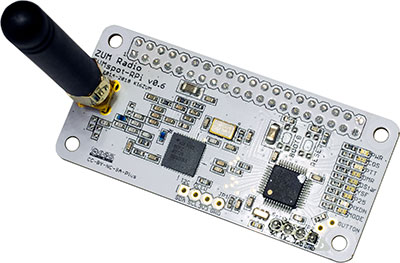 The ZUMspot-RPi Board is the same size as and works well mounted on a Raspberry Pi Zero W. It also can be mounted on the faster RPi Zero 2 W, 3B+, 3A+, or 4B, as well as most of the older RPi boards. Requires a digital radio.
The ZUMspot-RPi Board is the same size as and works well mounted on a Raspberry Pi Zero W. It also can be mounted on the faster RPi Zero 2 W, 3B+, 3A+, or 4B, as well as most of the older RPi boards. Requires a digital radio.
It's a Multi-Mode Digital Voice Modem that works with DMR, D-STAR, YSF, P25, NXDN, various cross modes, and POCSAG.
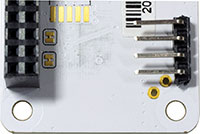 The ZUMspot-RPi Board 3 v0.6 includes a pre-installed Nextion display header connection, as well as these updates:
The ZUMspot-RPi Board 3 v0.6 includes a pre-installed Nextion display header connection, as well as these updates:
- EMI (ElectroMagnetic Interference) improvements.
- The I2C connector moved to make make it easier to mount 0.96″ and 1.3″ OLED displays.
- The SDA/SCL pins for OLED now connected to the GPIO pins (previously to the STM32 pins).
- The voltage supplied to the Nextion port changed from 3.3V to 5V.
- Two new LEDs added: NDXN and MODE (other).
Availability
U.S. – In the U.S., the ZUMspot is available from Ham Radio Outlet in a couple configurations:
- ZUM Radio ZUMspot Nextion 3.5″ kit
 , which includes a ZUMspot Pi UHF Board and antenna, a built-in 3.5″ Nextion display, an RPi Zero WH, a case, a 2.4A Power Supply, and a microSD card preloaded with Pi-Star.
, which includes a ZUMspot Pi UHF Board and antenna, a built-in 3.5″ Nextion display, an RPi Zero WH, a case, a 2.4A Power Supply, and a microSD card preloaded with Pi-Star. - ZUM Radio ZUMspot with attached 1.3″ OLED display kit
 , which includes a ZUMspot Pi UHF Board and antenna, a built-in 1.3″ OLED display, an RPi Zero WH, and a microSD card preloaded with Pi-Star.
, which includes a ZUMspot Pi UHF Board and antenna, a built-in 1.3″ OLED display, an RPi Zero WH, and a microSD card preloaded with Pi-Star.
Additional and new ZUM Radio products
HRO also carries a variety of other ZUM Radio boards and accessories. To find these products, just do a search at HRO on "ZUM Radio."
Cases
There also are a variety of C4Labs cases designed specifically for the ZUMspot board![]() , for use with RPi Zero W/Zero 2 W or RPi 3B/3B+ computers, and optionally with OLED or Nextion displays.
, for use with RPi Zero W/Zero 2 W or RPi 3B/3B+ computers, and optionally with OLED or Nextion displays.
Setup and support info
- Note: As of July, 2023, there are new official, custom-built images available for the ZUMspot Mini 1.3 and Elite 3.5 hotspots using W0CHP-PiStar-Dash (WPSD)
 , which is based on the new and improved Raspberry Pi Bullseye operating system.
, which is based on the new and improved Raspberry Pi Bullseye operating system. - Radio/Modem Type:
ZUMspot - Single Band Raspberry Pi Hat (GPIO) - Firmware upgrade script:
sudo pistar-zumspotflash rpi - Support: You can find support for ZUM Radio products in a few places:
- You can try contacting the store where you purchased them.
- If you use Facebook, you can try the Official ZUMspot and ZUM Radio Products Group
 on Facebook.
on Facebook. - You can try the ZUMspot section of the Pi-Star User Forum
 . I don't think the ZUM Radio team monitors that much, if at all, but other ZUMspot users may be able to help you.
. I don't think the ZUM Radio team monitors that much, if at all, but other ZUMspot users may be able to help you. - If all else fails, you can try sending an email to support@zumradio.com.
- A good video: ZUMspot setup with Pi-Star for the Kenwood TH-D74
 by Don, W6GPS. In the first half of his video, Don explains the general initial configuration of a ZUMspot using Pi-Star. In the second half, he explains setting up the Kenwood TH-D74A for use with a hotspot.
by Don, W6GPS. In the first half of his video, Don explains the general initial configuration of a ZUMspot using Pi-Star. In the second half, he explains setting up the Kenwood TH-D74A for use with a hotspot.
2d) Amateur Radio Toys
By Winters Huang, BI7JTA.
Huang is quite passionate about amateur radio and hotspots. He has designed a variety of boards. He also provides friendly support for his hotspots. A digital voice radio is required.
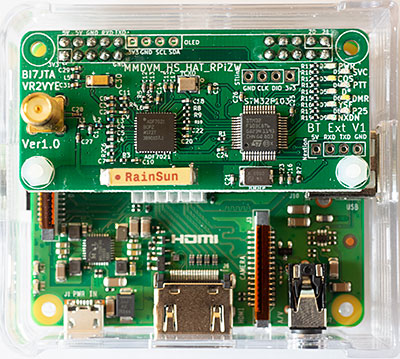 I've used the ART simplex hotspot called the MMDVM_HS_HAT_RPiZW (a.k.a., ZW_SPOT HAT) by BI7JTA and VR2VYE
I've used the ART simplex hotspot called the MMDVM_HS_HAT_RPiZW (a.k.a., ZW_SPOT HAT) by BI7JTA and VR2VYE![]() . It has an RPi Zero W form factor, though I have it mounted on an RPi 3A+.
. It has an RPi Zero W form factor, though I have it mounted on an RPi 3A+.
Because I've had good success with onboard antennas, I ordered a custom version with a RainSun onboard ceramic antenna.
The board also came with an SMA antenna mount, which I removed after taking this photo.
I've also used the ART simplex hotspot called the hotSPOT for RPi (a.k.a., RPi hotSPOT with Cool FAN) by BH7NJF and BI7JTA![]() . I have it mounted on an RPi 3B+ in the "official" RPi 3 case
. I have it mounted on an RPi 3B+ in the "official" RPi 3 case![]() . (As you can see, I had to tweak the case a bit to make everything fit. I also drilled an opening in the bottom of the case so I could mount a heat sink on the chip that's on the bottom of the RPi 3B+.)
. (As you can see, I had to tweak the case a bit to make everything fit. I also drilled an opening in the bottom of the case so I could mount a heat sink on the chip that's on the bottom of the RPi 3B+.)
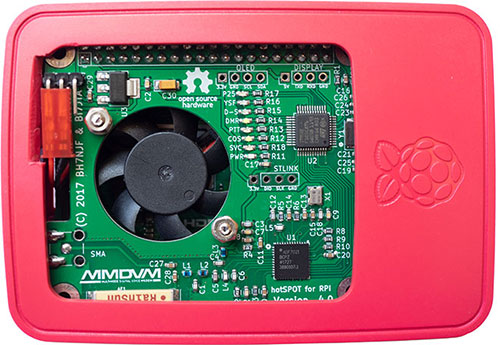
The RPi hotSPOT with Cool FAN has the form factor of an RPi 3A+, but this is a great board to run on an RPi 3B+ because of its very quiet but effective built-in fan, which helps keep the hot 3B+ running cooler. When I'm running the hotspot, I keep the case cover off; at other times, I keep it on to keep the dust out. Bonus: the RxOffset needed no adjustment!
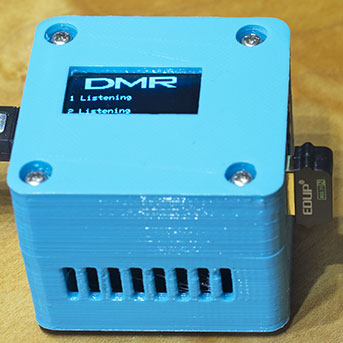 I also previously tried the simplex Nano hotSPOT(BlueBox) for MMDVM
I also previously tried the simplex Nano hotSPOT(BlueBox) for MMDVM![]() . It's very compact and works well, though it's slow, presumably due to the specs of the NanoPi NEO computer
. It's very compact and works well, though it's slow, presumably due to the specs of the NanoPi NEO computer![]() it uses. Amazingly for its compact size, it has a built-in OLED display, a fan, and even full-sized ethernet and USB ports (the USB port can be used for a WiFi dongle).
it uses. Amazingly for its compact size, it has a built-in OLED display, a fan, and even full-sized ethernet and USB ports (the USB port can be used for a WiFi dongle).
Additional products
Amateur Radio Toys also makes a Duplex hotspot board![]() , a repeater board, and some other products, though I haven't tried any of those. The boards come in a variety of configurations: as bare boards or with various cases, and with optional Nextion or OLED displays.
, a repeater board, and some other products, though I haven't tried any of those. The boards come in a variety of configurations: as bare boards or with various cases, and with optional Nextion or OLED displays.
Setup and ordering info
- Radio/Modem Type:
STM32-DVM / MMDVM_HS - Raspberry Pi Hat (GPIO) - Firmware – These use standard firmware by Andy, CA6JAU (juribeparada / MMDVM_HS
 ). To update the firmware via Pi-Star:
). To update the firmware via Pi-Star:
sudo pistar-mmdvmhshatflash hs_hat - Website: Amateur Radio Toys by BI7JTA
 . Easy ordering and fast shipping.
. Easy ordering and fast shipping. - Blog: BI7JTA BLOG for MMDVM

- Facebook: Amateur Radio Toys
 ; Twitter: @Winters_CN
; Twitter: @Winters_CN
- GitHub: bi7jta

3) The components
A personal, low-power hotspot is like your own personal repeater and gateway computer. Similar to a repeater, it's capable of receiving and transmitting RF, though at a very low power level, typically, 10mW or 0.01 watts. Like a gateway, it's also capable of connecting to the internet to send and receive data.
Many personal, low-power hotspots are made up of some kind of radio/modem board with an antenna that is mounted on a small computer like a Raspberry Pi. The functionality of these two components also can be combined into a single board, as is the case with the SharkRF openSPOT. The hardware typically includes built-in WiFi and/or an ethernet port, and in some cases, various other ports (USB, HDMI, etc.) and pins or through-holes that enable connecting peripherals like displays.
A hotspot has software controlling its overall operation. In addition, an MMDVM-based radio/modem board component has firmware controlling its core functions. Usually, software and firmware can be upgraded by the end user, enabling the hotspots to incorporate feature updates and fixes.
- Here's a closer look at some key personal, low-power hotspot topics:
3a) Radio/modem board
I'm most familiar with hardware components of the MMDVM-based radio/modem boards, so I'll focus on them for this explanation. I had the good fortune to meet Dave, KC6N, via email, and he shared insights with me about how they work. What he pointed out made me appreciate these little boards even more.
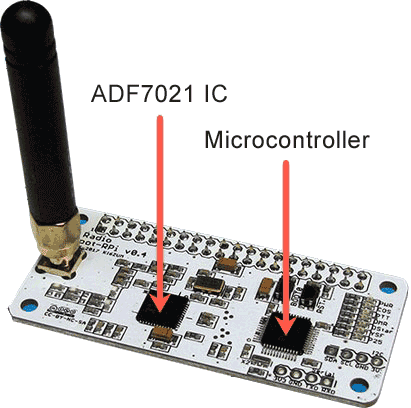 Here's what I understood: the MMDVM-based personal, low-power hotspots have a radio/modem board with two primary chips (shown here on a ZUMspot), and the radio and modem functions are distributed between those two chips.
Here's what I understood: the MMDVM-based personal, low-power hotspots have a radio/modem board with two primary chips (shown here on a ZUMspot), and the radio and modem functions are distributed between those two chips.
One of those primary chips is an Analog Devices ADF7021 Integrated Chip, a low-power 2FSK/3FSK/4FSK* transceiver. The ADF7021 generates RF signals and handles audio tones used by our digital radios to represent 1s and 0s.
The other primary chip is a microcontroller, a small computer on a single integrated circuit. It does the digital work, builds the packet frames, and programs and controls the ADF7021.
Thanks, Dave, for taking the time to share your knowledge and patiently explain this to me; it's at times like these that I appreciate the amateur radio community the most. If you'd like to dive into all of us this a bit more deeply, Dave created a good presentation about all of this: Digital Voice for Amateur Radio, 2018, which is available to members of the PAPA System![]() (the PAPA System, which is a 501(c)(3) organization, and operates for the benefit of the amateur radio community, offers trial guest memberships).
(the PAPA System, which is a 501(c)(3) organization, and operates for the benefit of the amateur radio community, offers trial guest memberships).
Hint: A common issue with some hotspots, especially those that use clone radio/modem boards like the Jumbospot, is high Bit Error Rate (BER > 1%). If you experience this when transmitting, see Fine tuning to reduce high BER![]() .
.
[*] FSK = Frequency Shift Keying; 2FSK is used for D-STAR, and 4FSK is used for DMR, YSF, P25, and NXDN, which explains why software-based cross-mode transcoding is possible between the latter four, but not so easily with D-STAR. However, at least one new hotspot, the SharkRF openSPOT3, is incorporating an AMBE® chip in order to add hardware transcoding that works with D-STAR.
3b) Processing and connectivity
With the MMDVM hotspots, the radio/modem board handles the tasks related to the radio signals, and a small computer handles the rest of the processing tasks, as well as the internet connectivity tasks, and the hotspot's power processing.
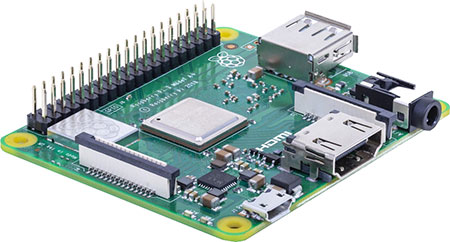 A primary hotspot component handled by the computer is the Gateway, which communicates with the internet. For an MMDVM-based hotspot, that's handled by a computer like a Raspberry Pi, which the radio/modem board is mounted on.
A primary hotspot component handled by the computer is the Gateway, which communicates with the internet. For an MMDVM-based hotspot, that's handled by a computer like a Raspberry Pi, which the radio/modem board is mounted on.
The MMDVM-based radio/modem boards can be mounted on and work well with a variety of Raspberry Pi models, most commonly the compact Zero W and the faster and more powerful Zero 2 W, 3B, 3B+, 3A+, and 4B. They'll also work on most of the older models that have a 40-pin GPIO connector. Some MMDVM-based radio/modem boards are designed to work with other small computers like the NanoPi Neo, but those aren't as common. As I mentioned earlier, some hotspots incorporate both the radio/modem and computing components onto a custom single board.
My current favorite Raspberry Pi boards are the Zero 2 W and the 3A+. The Zero 2 W retains the same compact form factor as the original Zero W. but is much faster, which is great for procedures like Pi-Star startup and updating. The 3A+ is a nice balance between form factor size and performance. It's much faster than the Zero W, more compact than the 3B+/4B, and also runs much cooler than the 3B+/4B, while not much warmer than the Zero W. You gain a single USB 2.0 port over the Zero W/2 W; however, there's no ethernet port, though that's fine for me as I primarily use WiFi for my hotspots. The RPi 3B is also a good board. In my opinion, the RPi 4B is overkill for a hotspot.
3c) Firmware
The radio/modem's firmware controls its key functions. Most MMDVM-based modems use the firmware developed by Andy, CA6JAU (GitHub: juribeparada / MMDVM_HS![]() ). You can find the latest releases and release notes at ZUMspot/MMDVM_HS firmware
). You can find the latest releases and release notes at ZUMspot/MMDVM_HS firmware![]() . Other hotspots, such as the openSPOT and the DVMEGA, use their own firmware.
. Other hotspots, such as the openSPOT and the DVMEGA, use their own firmware.
It's a good practice to keep the firmware up to date, as the updates include fixes, updated features, and changes to ensure they work with the latest hardware.
The ZUMspot/MMDVM_HS firware can be updated easily via Pi-Star (see Performing firmware updates via Pi-Star![]() ). To use Pi-Star's firmware updating script, you need to know the exact firmware update command to use, which you can learn from the manufacturer or vendor of your MMDVM-based hotspot.
). To use Pi-Star's firmware updating script, you need to know the exact firmware update command to use, which you can learn from the manufacturer or vendor of your MMDVM-based hotspot.
3d) Software
The openSPOT uses its own well-designed and feature-rich software. Setup and use is straightforward.
Most of the other current hotspots are MMDVM-based and work well with the Pi-Star app. Setup is relatively easy, especially since many of them can use Pi-Star's Auto AP feature for wireless network configuration (requires a recent RPi like the Zero W/Zero 2 W, 3B, 3B+, 3A+, or 4B).
3e) LEDs
You need to view the LEDs from the perspective of the hotspot.
MMDVM-based hotspots:
- PTT (Push-to-Talk) – Lights up when the hotspot has received data from the internet and is transmitting (Tx) it out via RF. When this is happening, your digital radio will be receiving.
- COS (Carrier Operated Switch) – Lights up when the hotspot's receiver squelch is open and an RF signal is being received (Rx). This happens when you press your digital radio's PTT in order to transmit.
- Modes (D-STAR, DMR, YSF, P25, NXDN, OTHER) – These light up when the hotspot is in a specific mode. If you have multiple modes active and there is no activity, the hotspot will scan those modes looking for activity, so their LEDs will flash in succession. When there is activity, the current mode's LED will be lit, and it will remain lit after the activity finishes for the amount of time the hotspot continues listening on that mode (see the Pi-Star configuration Hangtime setting
 ).
).
SharkRF openSPOT:
- Multi-mode LED – The SharkRF openSPOT has a unique multi-mode, multi-colored LED that displays a variety of states via the colors being displayed and the pattern with which they are being displayed.
- Here's a visual overview of the openSPOT2 Status LED states
 .
. - And here's a visual overview of the openSPOT3 Status LED states
 .
.
- Here's a visual overview of the openSPOT2 Status LED states
3f) Buttons
The SharkRF openSPOTs have one or two buttons:
- The openSPOT3 has two buttons
 openSPOT3 has two buttons
openSPOT3 has two buttons , a power button, and a WiFi/multi-mode button that you can press for three seconds to switch between normal mode and Access Point (AP) mode. You also can press the WiFi button for 30 seconds to perform a factory reset.
, a power button, and a WiFi/multi-mode button that you can press for three seconds to switch between normal mode and Access Point (AP) mode. You also can press the WiFi button for 30 seconds to perform a factory reset. - The openSPOT2 has a single multi-mode button
 . You can press it for three seconds to switch between normal mode and Access Point (AP) mode. You also can press it for 30 seconds to perform a factory reset.
. You can press it for three seconds to switch between normal mode and Access Point (AP) mode. You also can press it for 30 seconds to perform a factory reset.
MMDVM-based radio/modem boards sometimes have one or more push buttons, for example, on the ZUMspot-RPi v0.4, you'll see:
- RST – The reset button forces a reset of the STM32 chip.
- BOOT0 – When BOOT0 is pressed, the STM32 chip starts in bootloader mode and will wait for a firmware update.
- Note 1: If you run a firmware update via SSH using the easy built-in Pi-Star command for the ZUMspot, the script automatically toggles the BOOT0 and RST pins. For more info, see Performing firmware updates via Pi-Staron
 .
. - Note 2: To initiate a manual firmware update on the ZUMspot, you either can press BOOT0 while powering on the board, or press BOOT0 and RST simultaneously when the board is powered on. For more info, see the manual firmware update process outlined on the ZUMspot/MMDVM_HS GitHub page
 .
.
- Note 1: If you run a firmware update via SSH using the easy built-in Pi-Star command for the ZUMspot, the script automatically toggles the BOOT0 and RST pins. For more info, see Performing firmware updates via Pi-Staron
3g) Through-holes
MMDVM-based radio/modem boards also can have various sets of plated through-holes you can use to connect a variety of peripherals, for example, you might solder in a 4x1 straight or right-angle pin header connector that you can use to connect a cable from a display. A couple of through-hole sets you might see:
- I2C (Inter-Integrated Circuit) – Can be used for an OLED display.
- On the ZUMspot v0.4 board, this set is connected to the clock (SCL) and data (SDA) pins on the STM32 chip. On the ZUMspot v0.6 board, the SDA/SCL pins are connected to the GPIO pins.
- Serial – Can be used for a Nextion display. Used as part of the serial passthrough in MMDMVMHost, and also can be used as a debug port.
- Note 1: TX on the Nextion display connects to the RX through-hole, and RX on the display connects to the TX through-hole.
- Note 2: My 3.5″ Nextion Basic NX4832T035 and 3.2″ Nextion Enhanced NX4024K032 displays run fine using the 3V3 (3.3 volt) connection on the ZUMspot v0.4 board. I've tested this with both the RPi 3B and Zero W using a quality 2.5A power supply. I've heard others have needed to connect to a 5-volt GPIO pin. On the ZUMspot v0.6 board, it's now a 5V connection.
- Note 3: On a ZUMspot, this is connected to the Universal asynchronous receiver/transmitter (UART) on the STM32 chip.
3h) Cases and cooling fans
The SharkRF openSPOTs come with their own cases and don't need fans.
Many MMDVM-based hotspots are sold as bare boards, so you might want to purchase or make a case. Depending on the Raspberry Pi you use, you also might want or need a fan.
Handmade hotspot cases
Technically, you don't need a case for an MMDVM-based hotspot; I've used some of mine with just the bare boards, connected together with standoffs, and with some short standoffs beneath to provide feet. But it's really nice to put them in a proper case. Here are some examples of handmade and manufactured cases.
I'm a woodworker, so for fun I decided to make a few hotspot cases out of some thinwood I had left over from my woodworking projects, as well as a few other scraps. I've designed and built several different cases as I experimented with various combinations of RPi boards, batteries, displays, and shapes.
Desk hotspot
I keep one hotspot on my writing desk so I can test things out as I'm researching new features.
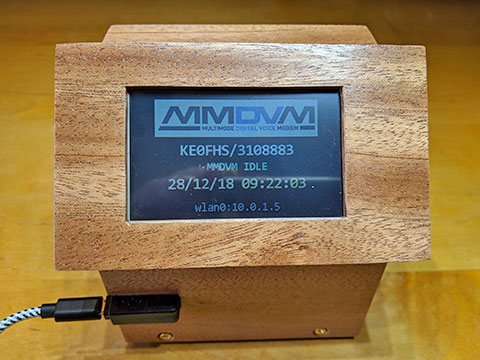
One thing I realized is that I have no problem using my hotspots when I'm in another room with a thick wall in between, which means I really don't need to have the antenna sticking out of the box. So my goal was to make something clean looking with the screen at an angle for easier viewing when I'm typing.
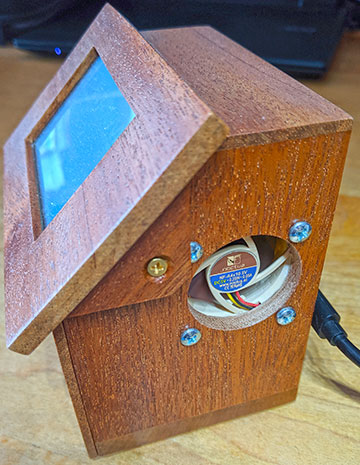 This case includes a 3.2″ Nextion enhanced display. Initially, it had a ZUMspot mounted on a RPi 3B+ inside. Later, I upgraded to an RPi 4B (a board that I think is generally overpowered for a hotspot, but I wanted to experiment with it). Therefore, I changed the case to incorporate a USB-C power connector, mounted a CanaKit PiSwitch (USB-C) on the back, and added a fan and some more ventilation holes to compensate for the extra heat the RPi 4B generates. The updated design works well.
This case includes a 3.2″ Nextion enhanced display. Initially, it had a ZUMspot mounted on a RPi 3B+ inside. Later, I upgraded to an RPi 4B (a board that I think is generally overpowered for a hotspot, but I wanted to experiment with it). Therefore, I changed the case to incorporate a USB-C power connector, mounted a CanaKit PiSwitch (USB-C) on the back, and added a fan and some more ventilation holes to compensate for the extra heat the RPi 4B generates. The updated design works well.
Mobile hotspots
The design for my mobile hotspots was influenced by two goals: a desire for compact simplicity and a hunger for operating time. I decided on a minimalist design: just an MMDVM-based radio/modem board mounted on an RPi Zero W in a box for protection and powered by a rugged external RAVPower 10050 mAh portable charger, which gives me a full day's capacity.
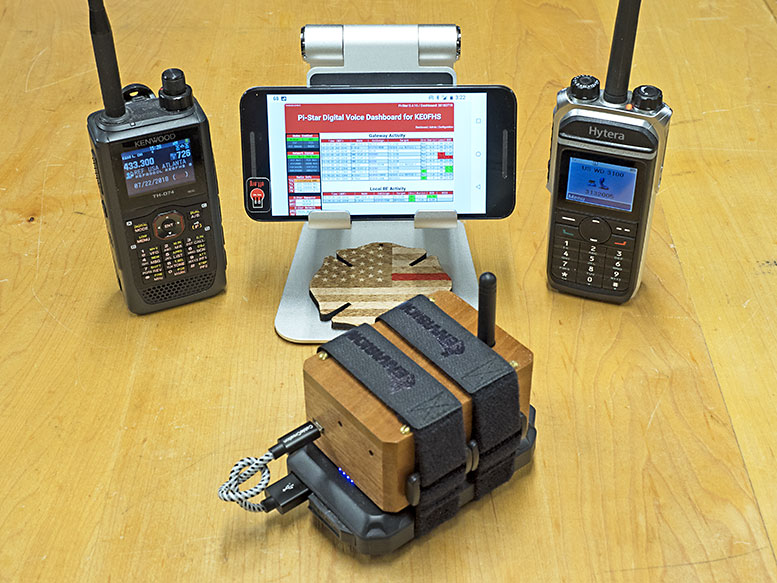
I added a right-angled micro-USB adapter inside the box to make plugging in easier (the plugin port aligns better with the port on the portable charger), as well as to reduce wear and tear on the RPi's micro USB port. The mahogany case fits nicely on top of the battery, attached with Soft Touch Velour cinch straps.
Jan 2019 update
Once Pi-Star 4, which supports the Raspberry Pi 3A+, became available, I upgraded my mobile hotspot to a combination of an RPi 3A+ and an MMDVM simplex board with a ceramic onboard antenna. I chose the RPi 3A+ because it's more compact and runs cooler than an RPi 3B+, while being a lot faster than an RPi Zero W. I ended up with a case that's not much bigger, and has the advantage of no awkward antenna sticking out.
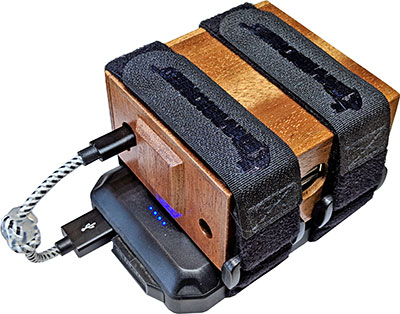
A good radio/modem board that uses a ceramic antenna is the Lonestar MMDVM Simplex. The SharkRF openSPOT v2 also uses a ceramic antenna.
Bonus: For my new mobile hotspot, I also left the RPi 3A+ USB port accessible so I can plug in an external Nextion display if I want.
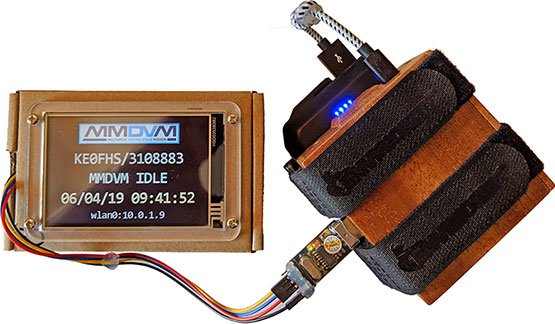
(For my Nextion test display, I simply made a case out of its box.)
Size comparison
Width Depth Height
Mobile hotspot: 3.37″ × 2.50″ × 1.75″
New mobile hotspot: 3.00″ × 2.90″ × 1.75″
External battery: 4.60″ × 2.80″ × 0.90″
Deck of cards: 3.60″ × 2.60″ × 0.70″
Power switches
For power switches, I use a variety of switches, including:
- The LoveRPi Power Switch
 , which includes a green status LED showing when it's on (important in a black box scenario). It also includes three rubber caps for the switch (green, red, and black). I used one switch as an external power port, with the other end connecting to the UPS, and a second switch between the UPS and the RPi.
, which includes a green status LED showing when it's on (important in a black box scenario). It also includes three rubber caps for the switch (green, red, and black). I used one switch as an external power port, with the other end connecting to the UPS, and a second switch between the UPS and the RPi.

- The CanaKit PiSwitch (Micro USB)


- The CanaKit PiSwitch (USB-C)

Cooling fans
When I started experimenting with the Pi-Star 4.0 Release Candidate running on the new (at that time) RPi 3B+, I noticed that my hotspots started heating up a bit more than normal. Then I read some early reviews about the RPi 4B, which I knew I'd want to try out, and noted that it has a heat signature that makes even the 3B+ look like a snowball on an iceberg. So I decided to add fans to a couple of my hotspots running those warmer boards. I've tried a bunch of different fans. Here are some of the better ones I've found.
Pimoroni Fan SHIM
The Pimoroni Fan SHIM is a good cooling solution. Certainly, it's the easiest, because there's no need for soldering connectors to the RPi. However, it's not effective when used with a radio/modem hat because there's not enough room between the hat and the RPi for adequate air flow. (That said, I did figure out a way to make use of just the Fan SHIM's shim, which I describe in a note further below.)
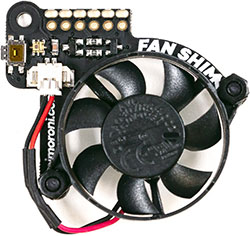
As the name suggests, it's a shim that slides onto the GPIO header, positioning the fan directly over the main chip on the Raspberry Pi and slightly over the RAM chip (which means you can't use heat sinks on those chips).
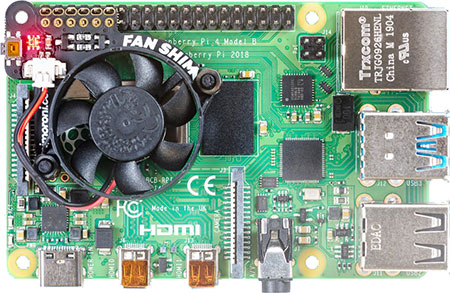
It's quieter than 40 or 50 mm fans, though of course it doesn't move as much air: the Noctua 40 mm fan (discussed next) mounted in a case typically keeps an RPi 4B CPU temp below 40°C, while the Pimoroni Fan SHIM keeps the CPU temp in the 45° – 50°C range, which is still totally fine (without a fan, the 4B runs 60°+ C).
Available from Adafruit![]() or directly from Pimoroni
or directly from Pimoroni![]() .
.
Pimoroni has a good Getting Started Tutorial![]() , which also covers installing and using the Python script you can use to control the fan on/off thresholds, etc.
, which also covers installing and using the Python script you can use to control the fan on/off thresholds, etc.
Noctua fans
After reading reviews about how some of the cheap 5V fans that are available for RPi boards wear out quickly and either get much noisier as their bearings degrade, or fail completely, I looked around for a better quality fan. I found a quite good one that is well designed, quite effective, reasonably quiet (though definitely noisier than the standard fans because they're moving more air), and engineered for longevity (they have a six-year warranty!): the Noctua NF-A4x10 5V![]() .
.
Initially, for use with a hotspot that is a radio/modem hat mounted on an RPi, I soldered connectors to the RPi GPIO pins 4 5V and 6 GND (for a good diagram, see: Raspberry Pi Pinout![]() ). Subsequently, I started using the Fan SHIM hack discussed above.
). Subsequently, I started using the Fan SHIM hack discussed above.
Although these fans are only 10 mm in height, they are a bit wider and deeper (40 mm x 40 mm) than a standard RPi fan. That's not a problem if you're making your own custom case, but if you're using a case designed for a typical RPi fan, these Noctua fans won't fit.
Note: The "10" in NF-A4x10 5V represents the 10 mm depth or thickness of the fan. They also make a heftier 20 mm thick version: Noctua NF-A4x20 5V![]() .
.
Other manufactured hotspot cases
Even though I like making some of my own cases, I also use some manufactured cases for test hotspots. For hotspots based on the RPi Zero W/Zero 2 W, 3B, and 3B+, I've used the really nice MMDVM cases made by C4Labs in Tacoma, Washington![]() .
.
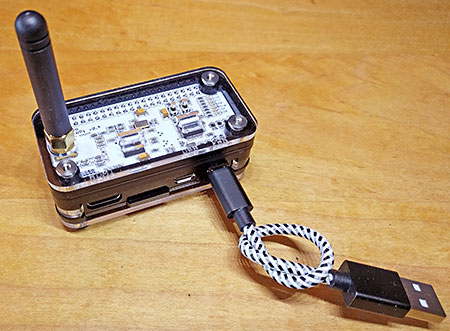
C4Labs case for a simplex hotspot with the RPi Zero W/Zero 2 W form factor

C4Labs case for a simplex hotspot with the RPi 3B/3B+ form factor
For the RPi 3A+, I use the very reasonably priced Adafruit Pi Model A+ Case Base and Lid![]() , which are available in a variety of colors. The case has plenty of room inside for an MMDVM-based radio/modem board. If needed, I drill a hole in the lid for the antenna, and a larger hole in the base so I can add a heat sink to the chip that's on the bottom of the RPi 3A+.
, which are available in a variety of colors. The case has plenty of room inside for an MMDVM-based radio/modem board. If needed, I drill a hole in the lid for the antenna, and a larger hole in the base so I can add a heat sink to the chip that's on the bottom of the RPi 3A+.
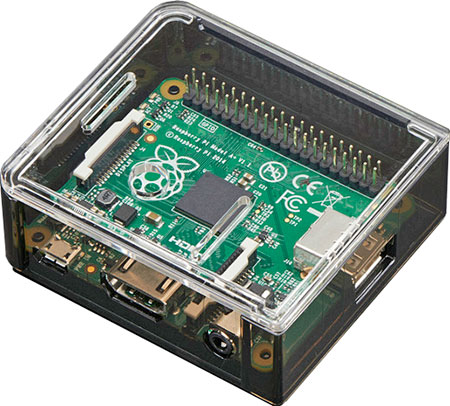
Adafruit Pi Model A+ Case
Here's a case that I modified for a dual hotspot. All I had to do was snip a couple openings out of the sides. I always use the smoked tops because the LEDs on many of the radio/modem boards are way too bright for me.
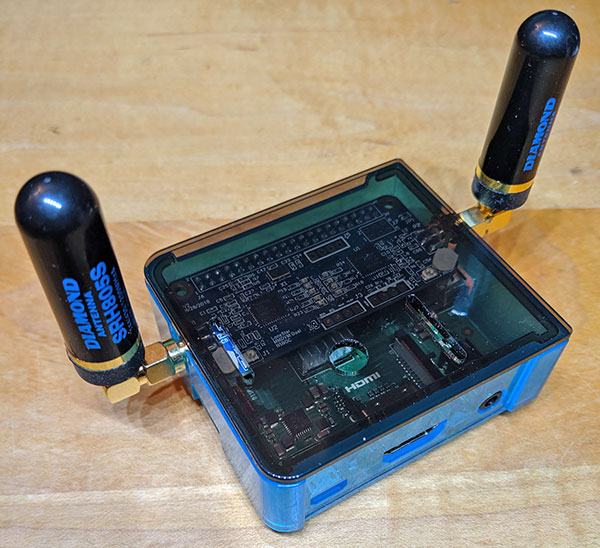
Hint: I also found that it helps to sand the catch at the back of these cases (on the GPIO header side) to make it easier to snap the 3A+ in place.
In July 2019, I noticed that Adafruit also has a similar case that fits the Model B+![]() , again very reasonably priced. It also fits the RPi 2, 3B, and 3B+.
, again very reasonably priced. It also fits the RPi 2, 3B, and 3B+.
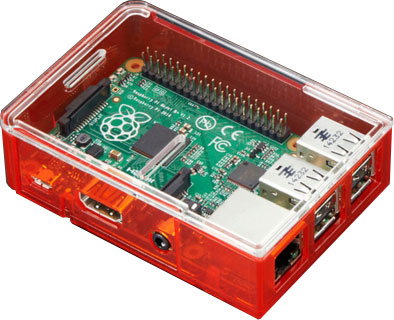
Adafruit Pi Model B+ Case
As with the A+ case, this case has plenty of room inside for an MMDVM-based radio/modem board. Again, I drill a hole in the lid for the antenna, and a larger hole in the base (before I snap the RPi 3B+ board in place) so I can add a heat sink to the chip that's on the bottom of the 3B+. This case also is available in a variety of base and lid colors, though once again, I prefer the smoked tops because the LEDs on many of the radio/modem boards are too bright for me.
3i) Displays
MMDVM-based hotspots can run various displays. The most common are Nextion displays in a variety of sizes and the smaller OLED displays.
I personally prefer the Nextion displays. The design of my Nextion display screens is a customization of the Nextion_ON7LDS![]() screens. My goal was to be able to look at the display from anywhere in my shop and tell at glance what's being received, so I made the screens for the different modes look quite different from one another, with colors related to their logos. I also like simple, calm screens, so the different text fields are displayed in various subtle colors, and there are no other eye candy embellishments, just the mode logo and the essential data.
screens. My goal was to be able to look at the display from anywhere in my shop and tell at glance what's being received, so I made the screens for the different modes look quite different from one another, with colors related to their logos. I also like simple, calm screens, so the different text fields are displayed in various subtle colors, and there are no other eye candy embellishments, just the mode logo and the essential data.
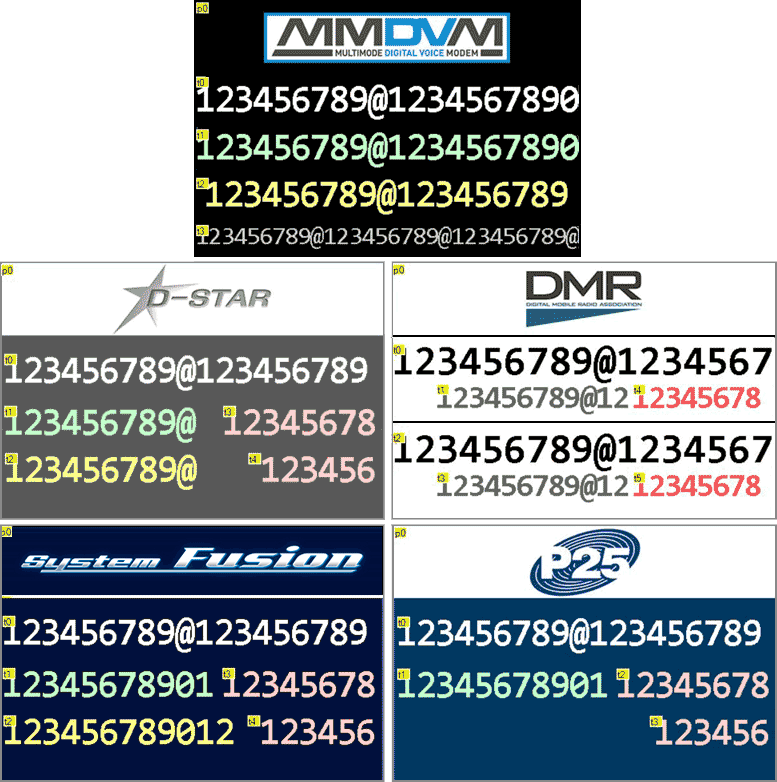
Thanks to Rob van Rheenen, PD0DIB, the Dutch ham and digital voice enthusiast who moderates the Nextion Ham-Radio Screens![]() Facebook group, and who generously provides excellent tutorials and mentoring. Thanks also to the hams who are sharing inspiring designs and support in that group.
Facebook group, and who generously provides excellent tutorials and mentoring. Thanks also to the hams who are sharing inspiring designs and support in that group.
Conclusion: While I enjoyed learning how to program the Nextion displays, in the end I don't think a display is a necessary component for a hotspot running Pi-Star (the one exception is that I appreciate being able to easily see the hotspot's IP address). That said, I find it worth it to add Nextion displays to some of my hotspots simply because doing so broadens my knowledge about both hotspots and electronics. Bottom line: Nextion displays are optional, fun, and instructional.
Notes:
- To connect the Nextion to a PC for programming: I use a USB to TTL UART CH340G Serial Converter (this one is by RobotDyn), along with some breadboard jumper wires. I also used breadboard jumper wires for soldering onto the display.
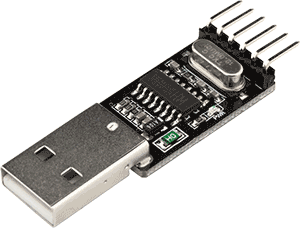
I also use these converters to temporarily connect my test Nextion units to the USB ports of some of my hotspots. - Nextion Editor: Can be downloaded from Itead: Nextion Editor
 .
.
- Note: When I started playing around with the Nextion displays, I used the Ver 0.53 Nextion Editor. In mid-2019, Itead released Nextion Editor Ver 0.58 (now Ver 0.59)
 . It introduces new features and updated fonts, but it's not backward compatible with projects built in older editors. There is a Long-Term Support alternative, Nextion Editor LTS
. It introduces new features and updated fonts, but it's not backward compatible with projects built in older editors. There is a Long-Term Support alternative, Nextion Editor LTS that does provide backward compatibility for projects created with older editors.
that does provide backward compatibility for projects created with older editors.
- Note: When I started playing around with the Nextion displays, I used the Ver 0.53 Nextion Editor. In mid-2019, Itead released Nextion Editor Ver 0.58 (now Ver 0.59)
- Installing the ON7LDS driver: If you decide to upgrade to the ON7LDS driver, make sure it gets installed to the correct directory.
- Per Dave, WB6DTB, in the Pi-Star User Forum
 : Sometimes when installing the ON7LDS Nextion Driver, the driver file doesn't get installed into the "/dev" folder. Go back and follow the installation instructions again and download the driver file again into the "/tmp" folder and then run the 'check_installation' script and it will tell you if the Nextion driver is installed. If it is installed it will tell you the folder where the Nextion driver file is located (probably at "/usr/local/bin"). If so, goto that folder and copy and rename the Nextion driver file to the "/dev" folder, using this command when in the folder where the driver is located currently:
: Sometimes when installing the ON7LDS Nextion Driver, the driver file doesn't get installed into the "/dev" folder. Go back and follow the installation instructions again and download the driver file again into the "/tmp" folder and then run the 'check_installation' script and it will tell you if the Nextion driver is installed. If it is installed it will tell you the folder where the Nextion driver file is located (probably at "/usr/local/bin"). If so, goto that folder and copy and rename the Nextion driver file to the "/dev" folder, using this command when in the folder where the driver is located currently: sudo cp NextionDriver /dev/ttyNextionDriver. Go back to the Pi-Star Configuration page and you should see the Nextion Driver now in the Port field drop down list as 'ttyNextionDriver'. Select the Nextion driver then apply changes, then reboot Pi-Star.
- Per Dave, WB6DTB, in the Pi-Star User Forum
- Nextion screen layouts:
- For a basic selection as well as the more detailed readme explanations of the differences between the layouts, see the Nextion subfolders of the g4klx/MMDVMHost GitHub page
 .
. - Rob, PD0DIB, also shares his screens via GitHub: PD0DIB/Nextion_HAM-radio-screens
 .
. - Ryan, WA6HXG, also shares nice screens and good explanations on his GitHub project page: WA6HXG/MMDVM-Nextion-Screen-Layouts
 .
.
- For a basic selection as well as the more detailed readme explanations of the differences between the layouts, see the Nextion subfolders of the g4klx/MMDVMHost GitHub page
- Tech tip from Rob, PD0DIB: You can control the active and idle screen brightness via Pi-Star's MMDVMHost Expert Editor, which should help preserve battery life for a mobile hotspot. For more info, see:
Brightness settings for Nextion Screen
 .
. - A note about the connector:
- Serial port: 4 Pin 2.54mm
- Cable plug: JST XH2.54
- Wikipedia: JST connectors
 ; Warning from the article: Some 2.50 mm parts are incorrectly sold on the internet as 2.54 mm (0.100 in)….
; Warning from the article: Some 2.50 mm parts are incorrectly sold on the internet as 2.54 mm (0.100 in)….
- Nextion data sheets:
4) Shout out to the innovators and enablers
In general, hotspots really put the amateur into amateur radio. For the most part, the creative innovation driving this branch of amateur radio forward is being done by passionate hams around the world with day jobs and families who are pouring their energy into these various projects in their spare time.
The upside is that we get this really innovative playground to play around in; the downside—or, depending on how you look at it, another upside—is that this really is an amateur endeavor: things don't always work; there are some rough edges; updates sometimes break stuff; it can take a while for new features that many people want to get implemented; sometimes the only way to make something work is with a soldering iron, a bit of cussing, and a lot of stubbornness; and some features aren't fully documented so it can take a lot of trial and error to figure them out. In other words … lots of fun to be had for an adventurous amateur!
A hearty thanks to all the innovators, tinkerers, mentors, and enablers for making it possible for the rest of us to enjoy the rich variety of systems and features that are now available in the digital voice playground! Here are some of the hams driving all of this forward:
4a) The tinkerers
There are tinkerers in countries all around the world who are designing boards and wielding soldering irons faster than any of the legendary six-shooter gunslingers of the Old West.
Jim McLaughlin, KI6ZUM
Jim is one of these genius tinkerers. He worked closely with Jonathan and Andy on the original MMDVM project, and is the guiding hand behind the ZUM Radio products. Here's a video of one of Jim's talks: Multimode Digital Voice Modem![]() , Pacificon 2018.
, Pacificon 2018.
Ákos Marton, HG1MA; Guus van Dooren, PE1PLM; David Dennis, N5BOC
Ákos, of SharkRF, Guus, of DVMEGA, and Dave, of LoneStar, are a few more of these geniuses. They have created their own uniquely innovative solutions for bridging digital radio and the internet.
And others …
There are a few others listed in The Hotspots section above. There are more who I've read about (try searching Twitter for MMDVM!), and I'm sure there are even more I haven't heard about yet.
For someone like me who thinks it's a pretty amazing accomplishment when I manage to solder on a GPIO header without melting the whole board … well, let's just say I'm impressed!
4b) The coders
There also are keyboard jockeys in countries all around the world who are writing solutions to create bridges between our digital radios, hotspots, and the internet that enable the rest of us to enjoy this fun playground.
Jonathan Naylor, G4KLX
Jonathan operates in a technical stratosphere. He has been creating important digital voice-related solutions for years, which he makes freely available to the hams who are innovating in the digital playground and helping to make amateur digital voice radio so exciting.
The fact that he does this as a side project is truly amazing. (In a video of a talk he gave about MMDVM, he mentioned how at one point his job took him away from home during the week for a period of time to a place that had few disturbances. This, he said with a somewhat mischievous grin, made it possible for him to spend his evening doing something useful … which turned out to be MMDVM!)
Jonathan is particularly passionate about opening things up so hams can participate fully in the hobby, not just as end users of systems and hardware. From his talk at Pacificon 2018: "A closed system in the face of an equivalent open system will never win."
Here's what Pi-Star's Andy Taylor says about this:
There are some more special people who we all owe a debt of gratitude for their willingness to release their software for free. Jonathan Naylor (G4KLX) for his most excellent DStarRepeater, ircDDBGateway suite, and more recently MMDVMHost and DMRGateway. These applications form the core of what makes Pi-Star what it is, and without these excellent applications Digital Voice for Amateurs would be an entirely different and barren landscape.
Here are a couple videos of Jonathan's talks: MMDVM![]() , 2017; The Road to the MMDVM
, 2017; The Road to the MMDVM![]() , Pacificon 2018.
See also: GitHub g4klx
, Pacificon 2018.
See also: GitHub g4klx![]() .
.
Jonathan shares his work freely with the amateur radio community. If you want to say thanks to him for all his great work: https://www.paypal.com/paypalme/mmdvm![]() .
.
Andrew Taylor, MWØMWZ
Andy's work has made a huge difference to the thousands of us around the world who use MMDVM-based hotspots and repeaters by creating Pi-Star and making it freely available. Andy did this as a side project and somehow still managed to find time for his full-time job, his family, and his studies. Website: www.pistar.uk![]() ; Github: Andy Taylor
; Github: Andy Taylor![]() .
.
Chip Cuccio, W0CHP
Chip is taking hotspot-based digital amateur radio to the next level with his
W0CHP-PiStar-Dash (WPSD), a highly modified fork of Pi-Star that introduces many new features and improvements, and it's based on the new and improved Raspberry Pi Bullseye operating system. W0CHP-PiStar-Dash (WPSD)![]()
José Uribe (Andy), CA6JAU
Andy made the firmware that powers many ZUMspot and MMDVM_HS-based boards, as well as some of the cross-mode gateways. If you ever hear a rumor about some awesome new feature or functionality, check out his GitHub page; chances are he'll already have a release ready with it. GitHub: juribeparada/MMDVM_HS![]() .
.
Norbert Varga, HA2NON
Norbert, of SharkRF, creates the elegant software that powers the openSPOT, cranking out a steady stream of updates that include improvements and new features. He also does a wonderful job of helping their international community of users in their forum.
4c) The mentors and all the other enablers
There are a bunch of hams hanging out in forums and groups around the internet answering question, solving problems, and giving guidance for all the various aspects of digital voice and hotspots. For the Pi-Star project, this includes Craig, W1MSG, who also produces tutorial videos![]() , and Andrew, M1DNS, as well as many others. Thanks to all the hams who are helping out in this way; I really appreciate the opportunity to learn by reading your posts!
, and Andrew, M1DNS, as well as many others. Thanks to all the hams who are helping out in this way; I really appreciate the opportunity to learn by reading your posts!
Finally, a shoutout to all the clubs and individuals who are putting up repeaters, reflectors, servers, gateways, bridges, and other equipment, as well as providing trainings for how to use it all.
5) Final notes and footnotes
- Part of the fun of playing with hotspots is learning so much.
5a) How I gain experience for writing these notes
I use or have used a bunch of different hotspots configured in various ways to test things like updating and upgrading, different options, and routine use, including:
- The SharkRF openSPOT1, openSPOT2, and openSPOT3 by HG1MA and HA2NON
- Several ZUMspots (v0.4 and v0.6) by KI6ZUM in different configurations
- LoneStar MMDVM Simplex (1V8) and Duplex (1V2) by N5BOC
- MMDVM_HS_Hat (v1.6) by DF2ET & DB9MAT
- MMDVM_HS_Dual_Hat (v1.3) by DF2ET, DB9MAT, & DO7EN
- ZW_SPOT HAT (v1) by BI7JTA & VR2VYE, Amateur Radio Toys
- RPi hotSPOT with Cool FAN (v4) by BH7NJF & BI7JTA, Amateur Radio Toys
- Nano hotSPOT blueBOX by BI7JTA
- DVMEGA DUAL (v1) by PE1PLM
- BlueStack-Micro+ (used with a DVMEGA) by PE1MSZ, running the BlueDV app by PA7LIM
- DVAP dongle by AA4RC and AE4JY
- The DV4mini and the DV4home by AG0X/DH6SAB and DG1HT
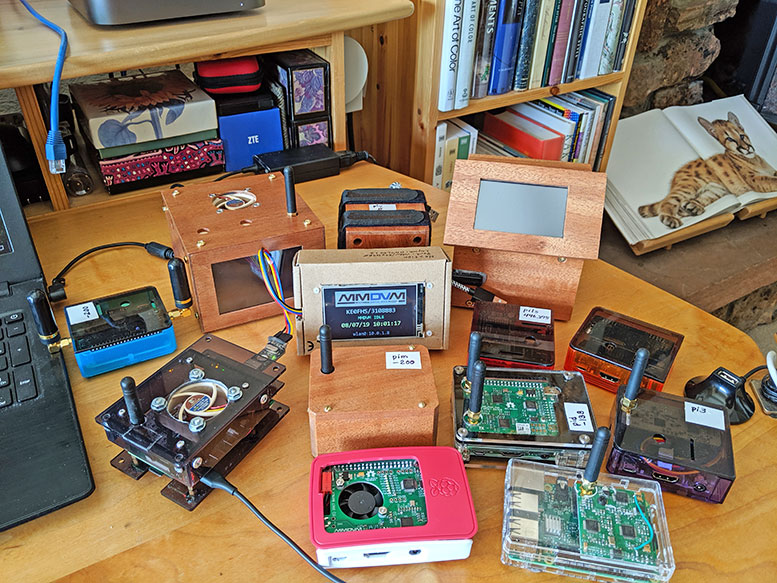
Most of my hotspots are based on the Raspberry Pi 3A+, 3B+, and 4B. While I like how small the RPi Zero W is and still have one hotspot based on it that I test with, I'm spoiled by the speed of the RPi 3A+/3B+/4B boards. The two hotspots I use the most, at my desk and in my shop, are currently based on the RPi 4B, both of which have custom cases with fans, but the 4B is more powerful than is needed for a hotspot.
I run several Nextion displays (enhanced 3.2″ and 3.5″), which I enjoy even if I don't find them necessary. I also tried a couple OLED units, which are fine, though I personally didn't like them much.
In addition to experimenting with my various hotspots, I read lots of online information related to hotspots, including tons of forum posts. As much as is practicable, I test what I write about, and I try to always note it when I mention something that I haven't personally tested.
5b) Hotspots: an opportunity to learn
Before I started using hotspots, I didn't know much of anything about digital voice (D-STAR and DMR were confusing concepts to me, and I hadn't heard of YSF, P25, or NXDN), didn't know the difference between a vocoder and a modulator or a reflector and a gateway, didn't really know how to solder, didn't know what a TCXO* chip is, had only heard about but had not tried the Raspberry Pi computer and its Linux-based Raspberry Pi OS operating system, didn't know what SSH is, and didn't know the difference between a pub and a GitHub.
Now I'm happily playing around with a couple different digital voice modes on a variety of Raspberry Pi models, soldering pin headers onto boards (my joints won't win any prizes, but hey, they work!), SSH'ing into the Pi-Star image and editing files with the Nano editor, figuring out what it means when a TCXO chip is bad, visiting GitHub regularly for a pint … um, I mean to read release notes, and learning more new stuff all the time.
In the grand scheme of things I'm still on the novice end of the spectrum, but it's so great to be able to play around with something that offers so many opportunities to learn about so many different things!
[*] Temperature-compensated Crystal Oscillator
5c) Footnotes
[1] Hotspots vs Personal Access Points – When I first started playing around with hotspots a few years ago, there tended to be more of a distinction between "hotspots" and "personal access points" (see the article Hotspots vs Access Points? by Jim, K6JM![]() ). While both perform a similar function—bridging radio and the internet to extend a local digital voice setup—hotspots tended to refer to higher-power devices, while access points referred to lower-power (~10 milliwatts) devices meant primarily for personal use. As the growth of the lower-power devices exploded over the past couple years, the term personal access point has pretty much disappeared, and now the term hotspot is commonly used to refer to the lower-power devices, too.
). While both perform a similar function—bridging radio and the internet to extend a local digital voice setup—hotspots tended to refer to higher-power devices, while access points referred to lower-power (~10 milliwatts) devices meant primarily for personal use. As the growth of the lower-power devices exploded over the past couple years, the term personal access point has pretty much disappeared, and now the term hotspot is commonly used to refer to the lower-power devices, too.
6) Other hotspot projects
- Here are a few notes about other hotspot projects I've come across. Some are older and a few are discontinued legacy projects. (There also are other projects that I've heard about but don't have any experience with, and likely still others that I haven't even heard about.)
6a) DVMEGA
By Guus van Dooren, PE1PLM.
[ Older, somewhat limited design ]
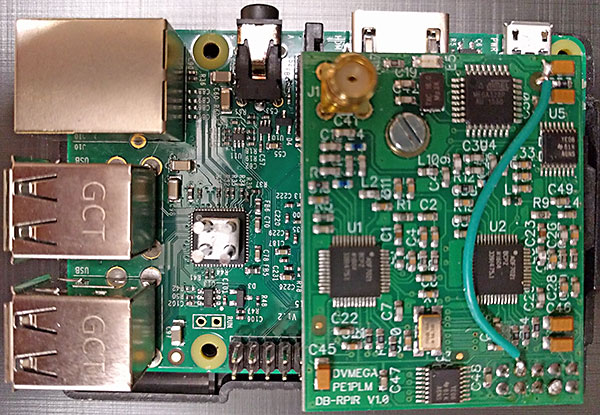 The DVMEGA comes in single-mode (UHF) and dual-mode (VHF/UHF) versions, both of which can be mounted on Raspberry Pi computers, and there are other models as well. The DVMEGA also can be mounted on a BlueStack board. A digital voice radio is required.
The DVMEGA comes in single-mode (UHF) and dual-mode (VHF/UHF) versions, both of which can be mounted on Raspberry Pi computers, and there are other models as well. The DVMEGA also can be mounted on a BlueStack board. A digital voice radio is required.
With firmware 3.07 and later, it can support D-STAR, DMR, and YSF. As far as I know, it doesn't support NXDN, P25, any cross modes, or POCSAG.
Works well with Pi-Star, and once you've soldered the firmware update jumper wire in place for Pi-Star, it's easy to update the DVMEGA in-house firmware via Pi-Star's command line. It's also possible to update the firmware when it's mounted on a BlueStack board connected to a PC, with the jumper wire soldered to different pins. For firmware info, see the note DVMEGA firmware update![]() .
.
A note about the shape: The DVMEGA has an odd form factor. Its GPIO connector is sized for 10 pins (2 rows of 5 pins) and it has a standoff in an odd place on the opposite side from the pins, between the pins and the antenna mount. I'm guessing this may have matched some older RPi, but it's a bit awkward on the current RPi 3B/3B+/3A+ boards. The standoff acts as a pivot point, so that if you touch the antenna, the GPIO connector can easily pull up off the pins.
To partially solve this, I took a full GPI0 connector, cut off 5 rows, pulled the pins out of the rest, and mounted that on the remaining GPIO header on the RPi. That creates a bit of a base that gives the DVMEGA a bit more stability, though it still can pull up from the GPIO pins, just not as easily.
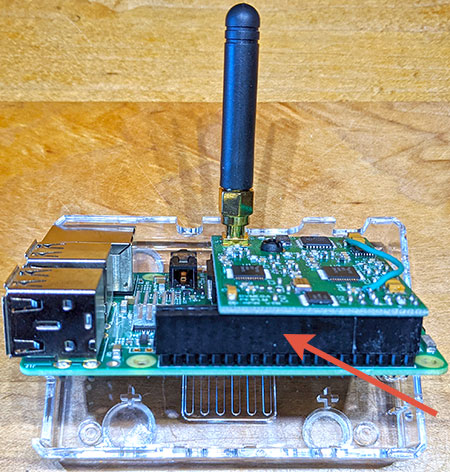
Additional products
- DVstick30
[ Newer product, but still somewhat limited design ]
USB stick with an AMBE-3000™ Vocoder chip. Plugs into a Windows PC (requires a sound card) and works without a radio. You can use the PC's microphone and speaker, or a headset. Works with the BlueDV app. As far as I know, it doesn't support NXDN, P25, any cross modes, or POCSAG.
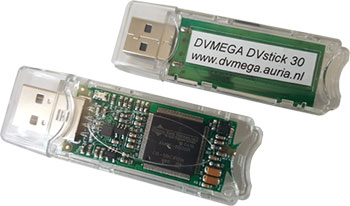
- DVMEGA Cast
[ Newer product, but still somewhat limited design ]
An AMBE-3000™ based multi-mode IP radio for DMR, D-STAR, and YSF. Includes a built-in speaker and a 2.4″ touchscreen. Its host system is based on the NanoPi, and has Pi-Star pre-installed. As far as I know, it doesn't support NXDN, P25, any cross modes, or POCSAG.
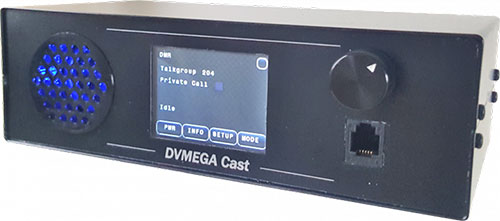
Suport and ordering info
Website: DVMEGA![]() .
.
Twitter: Guus van Dooren![]() .
.
6b) BlueStack-Micro+
By Ruud Kerstens, PE1MSZ.
[ For use with the DVMEGA ]
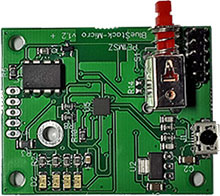 A companion board for the DVMEGA. The DVMEGA RPi board can be paired with the BlueStack-Micro+ instead of an RPi, which enables a bluetooth connection to an Android or iOS phone running BlueDV or a serial connection to a Windows computer running BlueDV.
A companion board for the DVMEGA. The DVMEGA RPi board can be paired with the BlueStack-Micro+ instead of an RPi, which enables a bluetooth connection to an Android or iOS phone running BlueDV or a serial connection to a Windows computer running BlueDV.
When powered by a portable battery pack, the BlueStack + DVMEGA combo provides a mobile solution that can be used with D-STAR, DMR, and YSF radios:
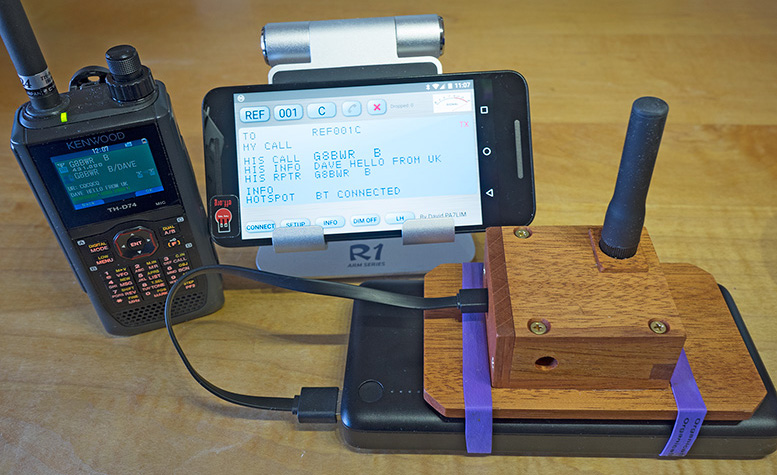
I made a case for the BlueStack + DVMEGA duo
out of some mahogany scraps
For more about this mobile solution: Just can't wait to get on the road again![]() .
.
The BlueStack board also can be used to facilitate a DVMEGA firmware update. For more info, see the note DVMEGA firmware update![]() .
.
Ordering and additional info
Website: pe1msz.nl![]() .
.
Supplier: Combitronics![]() .
.
6c) BlueDV apps
By David, PA7LIM.
[ For use with the DVMEGA and DVstick30 ]

David makes some really fun and innovative apps. He's continuously trying new things and pushing boundaries. BlueDV can be run on Android and Windows (experimental versions also available for iOS, Linux, and RPi), and is a good solution for a mobile hotspot using the BlueStack-Micro+ paired with a DVMEGA.
Note from David's website: "I am not a company! I just wrote the software for fun! (I have no commercial link with DVMEGA, Combitronics or others.) Hope you have a lot of fun with the software!"
Download and additional info
Website: BlueDV![]() .
.
Twitter: David PA7LIM![]() .
.
6d) DVAP dongle
By Robin Cutshaw, AA4RC, and Moe Wheatley, AE4JY, Internet Labs, Inc.
[ Older, intentionally limited design, may no longer be available ]
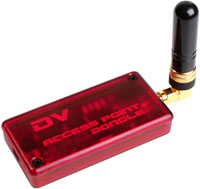 The DVAP was among the earliest personal hotspots available (my first hotspot was a DVAP). The DVAP was designed to be connected to a PC running Windows or a Mac, and to work with a D-STAR radio.
The DVAP was among the earliest personal hotspots available (my first hotspot was a DVAP). The DVAP was designed to be connected to a PC running Windows or a Mac, and to work with a D-STAR radio.
When running its own software, the DVAP works with only DPLUS (REF) reflectors, intentionally block access to XRF, DCS, and XLX reflectors, and doesn't support DMR, YSF, or P25 modes. I've read that some people use Pi-Star instead, but I don't have any experience with that.
Internet Labs also made the DV Dongle, which used a DVSI AMBE-2000™ chip, and later they released the DV3K dongle that used the newer DVSI AMBE-3000™ chip. But both of those appear to have been discontinued.
DV Air – At the 2017 Hamvention, they announced an upcoming "DV Air" product with built-in Bluetooth, WiFi, and ethernet. As of late 2019, I haven't found any further info, so I suspect it never went into production.
Additional info
Website: DVAP Dongle![]() .
.
6e) MMDVM_HS_Hat
By Florian, DF2ET, Mathis, DB9MAT, and Andreas, DO7EN.
[ Available in Germany only ]
The high quality MMDVM_HS_Hat line of boards from Germany is based on work by Jonathan, G4KLX, and Jim, KI6ZUM, and uses firmware by Andy, CA6JAU.
These boards handle D-STAR, DMR, YSF, P25, and NXDN, as well as the YSF and DMR cross modes, and POCSAG (Florian and Mathis were very active in POCSAG-related development). A digital-voice capable radio is required.
The designs were openly published on GitHub under a Creative Commons Attribution-NonCommercial-ShareAlike 3.0 license. Unfortunately, the designs were used in a way that is explicitly forbidden by the license as the basis for the unauthorized, lower-quality, commercial clones known as JumboSPOT or J-Hat.
MMDVM_HS_Hat Simplex
By Florian, DF2ET, and Mathis, DB9MAT.
[ May no longer be available ]
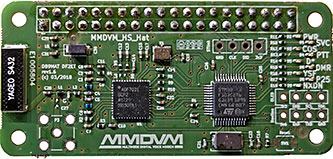
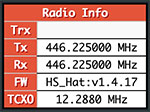 The newer versions of this board (1.6 and later) use a 12.288 MHz TCXO chip, while the older versions used a 14.7456 MHz chip. You also can see which TCXO chip your board has in the Radio Info module of the Pi-Star dashboard.
The newer versions of this board (1.6 and later) use a 12.288 MHz TCXO chip, while the older versions used a 14.7456 MHz chip. You also can see which TCXO chip your board has in the Radio Info module of the Pi-Star dashboard.
Support and ordering info
- Radio/Modem Type:
MMDVM_HS_Hat (DB9MAT & DF2ET) for Pi (GPIO) - Firmware upgrade script:
- MMDVM_HS_Hat board with 14.7456 MHz TCXO1 connected to GPIO:
sudo pistar-mmdvmhshatflash hs_hat - MMDVM_HS_Hat board with 12.288 MHz TCXO connected to GPIO:
sudo pistar-mmdvmhshatflash hs_hat-12mhz
- MMDVM_HS_Hat board with 14.7456 MHz TCXO1 connected to GPIO:
- MMDVM_HS_Hat on GitHub: mathisschmieder / MMDVM_HS_Hat
 .
. - Pre-configured Mouser cart: MMDVM_HS_Hat v1.6
 .
.
MMDVM_HS_Dual_Hat
By Florian, DF2ET, Mathis, DB9MAT, and Andreas, DO7EN.
[ May no longer be available ]
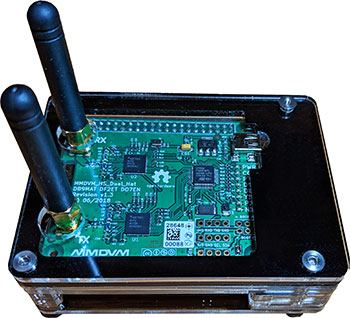
The newer duplex board uses a 12.288 MHz TCXO chip.
Support and ordering info
- Radio/Modem Type:
MMDVM_HS_Dual_Hat (DB9MAT, DF2ET & DO7EN) for Pi (GPIO) - Firmware upgrade script:
- MMDVM_HS_DUAL_Hat board with 14.7456 MHz TCXO conn to GPIO:
sudo pistar-mmdvmhshatflash hs_dual_hat - MMDVM_HS_DUAL_Hat board with 12.288 MHz TCXO conn to GPIO:
sudo pistar-mmdvmhshatflash hs_dual_hat-12mhz
- MMDVM_HS_DUAL_Hat board with 14.7456 MHz TCXO conn to GPIO:
- MMDVM_HS_Dual_Hat on GitHub: phl0 / MMDVM_HS_Dual_Hat
 .
.
Contact info
- Email: mmdvm@df2et.de.
- Twitter: Flo (DF2ET)
 and Mathis Schmieder
and Mathis Schmieder .
.
6f) Nano-Spot
By Mark Guidbord, K7IZA.
[ MAR 2020: Micro-Node has gone out of business ]
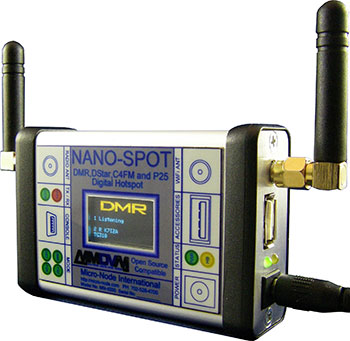 Per a note posted on his website:
Per a note posted on his website:
"Mark has decided to retire so Micro-Node will no longer be providing new product sales. Micro-Node will continue to honor and support current customers and products that are under warranty."
As of Jan 2021, the Micro-Node.com website has gone offline.
The Nano-Spot is a plug-n-play device. It includes built-in WiFi, RF and WiFi antennas, and an OLED display, all in a durable extruded aluminum case. Runs Pi-Star. Supports D-STAR, DMR, YSF, and P25. Requires a digital radio.
I haven't personally tried this hotspot. One thing to be aware of is that it uses custom firmware and it may also use a custom version of the Pi-Star software, so you are dependent on Mark for new versions, and may even need his assistance for some of the updating.
Hint: Heard this from Arthur, KC2IGS, who found a very creative way to get his Nano-Spot running again after he got locked out when he forgot his password. His method should be helpful when dealing with other issues, as well. The step-by-step process is well documented, including helpful photos: Nano-Spot Password or Firmware Reset![]() . Well done!
. Well done!
6g) ThumbDV
By Bryan Hoyer, K7UDR, Basil Gunn, N7NIX, John Hays, K7VE, and Dennis Rosenauer, AC7FT.
[ Older, limited design ]
 The ThumbDV is a USB device with a built-in AMBE3000™ chip, so it can be plugged into a computer that has a microphone and speaker, and doesn't require a digital radio. I haven't tried this hotspot so can't share much about it. Apparently it can support D-STAR, DMR, and YSF, depending on the hotspot software used. I even heard someone on a net who had the ThumbDV plugged directly into his Android phone (I'm guessing using BlueDV software). Sounded just fine.
The ThumbDV is a USB device with a built-in AMBE3000™ chip, so it can be plugged into a computer that has a microphone and speaker, and doesn't require a digital radio. I haven't tried this hotspot so can't share much about it. Apparently it can support D-STAR, DMR, and YSF, depending on the hotspot software used. I even heard someone on a net who had the ThumbDV plugged directly into his Android phone (I'm guessing using BlueDV software). Sounded just fine.
They appear to be more focused on other projects now, but the ThumbDV will be back in stock in late Apr 2023.
Ordering and additional info
Website: NW Digital Radio ThumbDV![]()
6h) Other projects
Here are a few other hotspots that I've tried or heard about:
DV4 devices
By Uli, AG0X/DH6SAB, and Torsten, DG1HT.
[ Likely discontinued ]
These are older and somewhat limited in design, and appear to be discontinued (their website is offline, all their products are out of stock, and their social media activity ceased in Jan 2018).
The DV4mini was a USB stick that could be plugged into a PC running Windows or Linux, or a Raspberry Pi.
The DV4home, released later, was a standalone digital voice device that had two AMBE® chips as well as its own screen, microphone, and speaker.
While I know people who have used and liked the DV4 devices, I personally found both the DV4mini and the DV4home V1 clunky to use when I tried them in 2016/2017. The DV4home's rotary knob was particularly poorly implemented—I found it almost unusable—and I've heard similar feedback from someone using V2. I also didn't like its bias for the DMR+ network. Too bad, because I had high hopes for using the DV4home as my digital base station, but it didn't work out.
Website: now offline.
Legacy devices
[ Discontinued ]
There are a couple earlier personal, low-power hotspots that I've read about, but were discontinued already by the time I started exploring hotspots:
- DUTCH*Star (website now offline)
- DVRPTR



